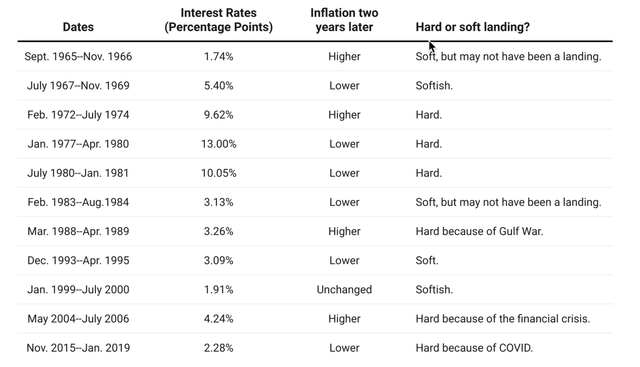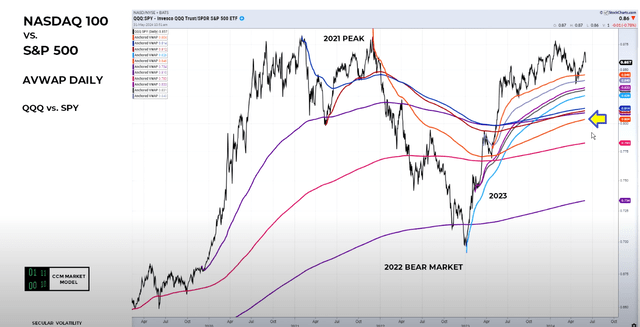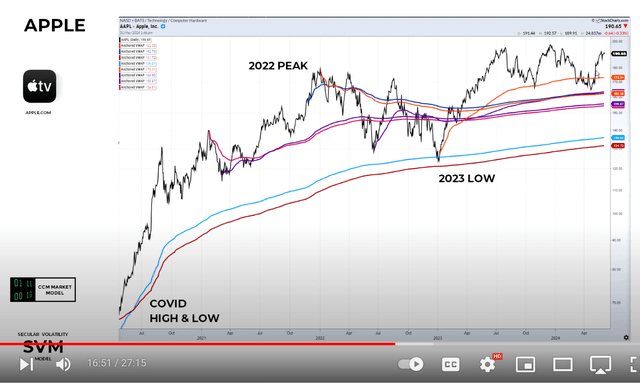Introduction: What Makes a Soft Landing?
The amount of talk on financial sites, channels, and articles about a soft landing is impressive indeed. A soft landing has a kind of instant market watcher alarm clock effect.
In order to understand whether a soft landing or some other kind is coming, we first need a clear definition:
“A soft landing implies the cooling down of the economy after a period of rapid expansion which happens smoothly.”
(It’s the cooling that happens smoothly, not the expansion. The expansion itself is probably fairly warm and combustible.)
Investopedia offers its own definition:
“A soft landing is a cyclical slowdown in economic growth that ends without a period of outright recession.”
A third definition, this one from former Federal Reserve Board Vice-Chair Alan Blinder:
“…if GDP declines by less than 1%, or the NBER doesn’t declare a recession after at least a year of a Fed rate-hiking cycle, he considers that a soft landing.”
Here’s a historical example of a soft landing, from the same Brookings article that quotes Alan Blinder:
“The classic example of a soft landing is the monetary tightening conducted under Alan Greenspan in the mid-1990s. In early 1994, the economy was approaching its third year of recovery following the 1990-1991 recession. By February 1994, the unemployment rate was falling rapidly, down from 7.8% to 6.6%. CPI inflation sat at 2.8%, and the federal funds rate sat at around 3%… the Fed was concerned about a potential pick-up of inflation and decided to raise rates preemptively. During 1994, the Fed raised rates seven times, doubling the federal funds rate from 3% to 6%. It then cut its key interest rate, the federal funds rate, three times in 1995 when it saw the economy softening more than required to keep inflation from rising.”
The Greenspan miracle soft landing suggests certain takeaways:
- A rapid recovery out of a recession carries later risk. Too rapid expansions lead to bouts of inflation that can turn exponential;
- A swift drop in unemployment can be a signal for an expansion that triggers inflation surges;
- Fear of inflation can lead to multiple rate hikes that create a ‘cure worse than the disease’ syndrome.
Alan Blinder points out that there have been five soft landings in 58 years.
Brookings Institution
The soft landing record is mixed at best.
A central bank simply does not exercise the same level of control over an economy that a pilot holds over an aircraft’s flight.
The Fed’s main policy tools – interest rates and asset holdings – are blunt instruments. They do not address phenomena such as supply chain interruptions or pandemic disruptions. A recession followed the last five instances when inflation peaked above 5% – in 1970, 1974, 1980, 1990, and 2008.
Former Federal Reserve Chairman Ben Bernanke described the difficulties of a soft landing with this metaphor:
“If making monetary policy is like driving a car, then the car is one that has an unreliable speedometer, a foggy windshield, and a tendency to respond unpredictably and with a delay to the accelerator or the brake.”
Federal Reserve Policy And A Soft Landing
An assumption at the root of this article is that the Federal Reserve is very much focused on engineering a soft landing from the current expansion.
This assumption is supported by Fed Chairman Jerome Powell’s responses to questions at the January meeting of the Federal Open Market Committee (FOMC). As a reminder, FOMC’s charge is determining the direction of monetary policy in the United States by directing open market operations (OMOs).
Asked whether the Federal Reserve had achieved a soft landing, ‘Jay’ Powell responded that he “wouldn’t say we’ve achieved that.”
“‘We’re… not declaring victory at this point… it’s a highly consequential decision to start the process of lowering interest rates ‘and we want to get that right.'”
Yet, the Fed remains wary of inflation and provably skeptical that a downward trajectory in the increase of the rate of inflation will continue.
Inflation’s Second Run?
The risks of renewed inflation are a main obstacle to the start of Federal Reserve Rate cuts. This issue was discussed in a CNBC segment with Jason Trennert of Strategas Research Partners.
Trennert referred to the news that Neel Kashkari, President of the Minneapolis Federal Reserve Bank, did not want to say in a recent interview that the Fed would begin interest rate cuts. Instead, Kashkari “is keeping mystery in this process.”
Trennert believes that Fed Governors speak too frequently about forward guidance, which confuses the markets. The wealth of statements reinforces the notion that the Federal Reserve does not know the future more than the rest of us.
This is because inflation is very hard to read, in Trennert’s opinion. Most relevantly, inflation may have a second wind:
“…there’s continued to be upward pressures on inflation, which are not going to go away anytime soon…once you have one wave of inflation over 6%, you get a second wave… the chances are about nine in 10…”
Despite this confidence in what many might see as a second inflation surprise, Trennert believes that Jay Powell and his colleagues are committed to a dovish path and will start lowering rates in September of this year.
A piece of evidence of a slow shift toward dovishness is easing off the Quantitative Tightening that was a partner to the interest rate increases.
“…the Fed had been allowing up to $95 billion a month in proceeds from maturing Treasurys and mortgage-backed securities to roll off each month. The process has resulted in the central bank balance sheet to come down to about $7.4 trillion, or $1.5 trillion less than its peak around mid-2022.”
“Under the new plan, the Fed will reduce the monthly cap on Treasurys to $25 billion from $60 billion. That would put the annual reduction in holdings at $300 billion, compared with $720 billion from when the program began in June 2022.”
The Federal Reserve has stopped vigorously throttling liquidity and is instead reducing it gently. It has stated an intent to end quantitative tightening soon.
What Do the Markets Say?
The course of the equity markets provides some guidance on the possible path to a soft landing. The markets are where institutional and retail investors put a major share of their assets, so the state of the markets does reflect macroeconomic realities, including inputs from the central banks.
Hedge fund manager and market historian Chris Ciovacco, who builds weekly technical presentations of market patterns in historical contexts, offered another interesting take this past weekend. The markets are uncertain, Ciovacco indicates, but lean toward bullishness.
One of the chart-based bull market indicators shows the Nasdaq vs. the S&P 500 in a five-year flow, with lines of resistance expressed by the course of moving averages. The evidence points to continued strength in the current bull market.
Chris Ciovacco YouTube Presentation
The performance of a bellwether like Apple Inc. (AAPL) is further confirmation of the self-assured nature of this bull:
Chris Ciovacco YouTube Presentation
Apple is both a bellwether and a large tech stock whose performance has been called into question by market observers. It has just recovered nicely from a recent low. Rather than being a halting bellwether encouraging broader market weakness, Apple is sturdy, stable, and a cause for hope.
The BlackRock Fixed Income investing guru Rick Rieder adds his own optimism on the markets to that of Ciovacco. Interviewed by CNBC’s Scott Wapner on the meaning of the market’s record high, Rieder responds with positivity:
“The technicals in the equity markets are staggering… the earnings are pretty good…you’re still throwing off 18, 19% ROE (return on equity) for the average S&P 500 company, pretty impressive.”
Rick Rieder emphasizes the importance of technicals and signals such as massive stock buybacks, nine trillion dollars sitting in cash, and ongoing wealth creation of individuals and retail investors through vehicles such as 401Ks. He acknowledges what he describes as “consumer moderation” but again refers to the great ROE numbers as bullish confirmation.
Rieder then predicts another 10%-15% rise in equity markets by the end of the year – in part because of one or two Federal expected interest rate cuts that should provide a ‘push’ to the markets.
He also downplays the effects of current “high” interest rates. Rieder refers to the huge piles of cash that many large and profitable firms have on hand; they actually benefit from higher interest rates in the form of short-term fixed instrument interest.
Corporate sensitivity to interest rates does not ring true when it comes to leading companies. In Rick Rieder’s words, they “are ‘much more insensitive to interest rates than they’ve ever been before.'”
The famous “Big Short” money manager Steve Eisman, Neuberger Berman Private Wealth manager, gave his own market analysis and forecast on Bloomberg Television. Predicting a Donald Trump victory in the November election, Eisman believes that the outcome will be clear by the time of the Democratic Convention in August.
Once the election outcome is clarified, investors will put money to work. He does not see potential Trump tariffs on China as materially impacting the US economy, which he describes as “…the most insular economy of any in the developed world.”
Eisman is also confident that Trump would not roll back the large-scale Biden Administration spending, given that half the monies currently go to “red” states. Economic policies will thus not change much.
Steve Eisman is not concerned about the impact on markets of the growing Federal deficits. While predictions of a deficit disaster have been coming “for 40 years,” disaster has not occurred. Don’t expect one any time soon.
Summary
At the start of 2024, market watchers expected as many as seven rate cuts. They believed that a turn to decisively dovish Fed policies was inevitable.
What has happened instead is that the Fed has slipped out of its hawkish posture into one that might be called neutral-waiting-to-go-dovish.
This slow drift through neutrality toward a drip-drip version of dovishness is partly a function of the Federal Reserve’s awareness of its “steering” limitations (“…the car…has an unreliable speedometer, a foggy windshield, and a tendency to respond unpredictably and with a delay to the accelerator or the brake”).
Beyond this, I think the Fed frets about the possibility of an inflation second run raised by Jason Trennert. If that happens, a dovish turn would quickly be replaced by renewed hawkishness that would build in some very uncertain scenarios.
Still, macroeconomic and market factors are largely positive. Economic and market conditions are better than many think, as Ciovacco, Rieder, and Eisman express cogently and clearly.
The Powell-led Federal Reserve knows about Ben Bernanke’s unwieldy vehicle and will steer with care. The chances of a soft landing are reasonable despite challenges, obstacles, and dangers along the way.
Read the full article here



